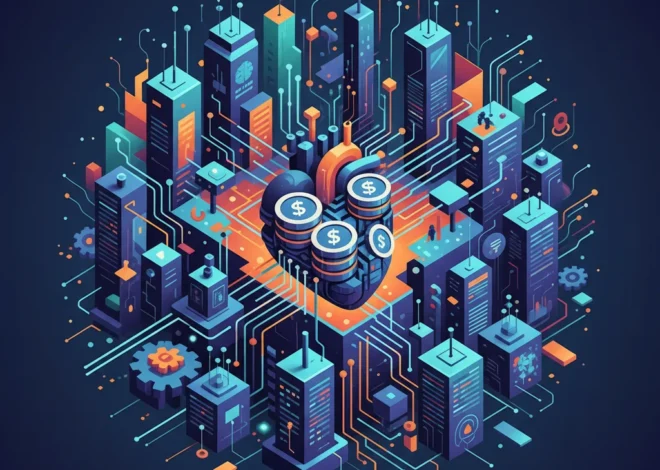
Is the AI Gold Rush a House of Cards? Why a Top Bank is Quietly Hedging Its Bets
The world is in the throes of an unprecedented artificial intelligence gold rush. From groundbreaking generative AI models to sophisticated automation software, the pace of innovation is staggering. For developers, entrepreneurs, and tech professionals, it feels like a limitless frontier. But behind the curtain of dazzling demos and soaring valuations, the “smart money” is starting to get nervous. And when a financial giant like Deutsche Bank begins quietly setting up an insurance policy against the very boom it’s funding, it’s time for everyone in the tech ecosystem to pay close attention.
In a move that should send a subtle but clear signal across the industry, Germany’s largest lender is exploring complex financial strategies to hedge its massive exposure to the data center market—the physical backbone of the entire AI revolution. According to a report from the Financial Times, executives are weighing options like shorting a basket of AI-related stocks or using derivatives to transfer risk. This isn’t just a boring banking story; it’s a canary in the coal mine for the sustainability of the current AI hype cycle.
The Unseen Engine of the AI Revolution
Before we dive into the financial wizardry, let’s ground ourselves in the physical reality of artificial intelligence. Every time you use an AI-powered tool, query a large language model, or run a machine learning algorithm, you are tapping into an immense, power-hungry infrastructure. This infrastructure is housed in sprawling, hyper-secure buildings called data centers.
These aren’t your average server rooms. AI-specific data centers are packed with thousands of specialized, high-performance GPUs (graphics processing units)—the kind that companies like Nvidia can’t make fast enough. They consume astonishing amounts of electricity and require sophisticated cooling systems to prevent them from melting down. Building and operating these facilities is an incredibly capital-intensive business, with costs running into the hundreds of millions or even billions of dollars.
Banks like Deutsche Bank have been happily lending money to the private equity firms and infrastructure funds that build these digital cathedrals. It’s been a lucrative business, as the demand for AI-powering cloud services seems insatiable. But this has led to what financiers call “concentration risk”—having too many eggs in one very specific, very expensive basket. What happens if the demand for AI compute suddenly slows down, or if a new, more efficient technology makes these billion-dollar investments obsolete overnight?
Decoding Wall Street’s Warning Shot: What is “Hedging”?
This is where the concept of hedging comes in. For those in the world of software and startups, a “hedge” is simply a strategic move to reduce risk. Think of it as financial insurance. Deutsche Bank is worried that while its loans to data centers are profitable now, a downturn in the AI sector could lead to defaults. To protect themselves, they’re considering two main strategies, as reported by the FT.
Let’s break down these complex financial maneuvers in a way that makes sense for a tech audience.
| Hedging Strategy | How It Works (Simplified) | Real-World Analogy |
|---|---|---|
| Shorting a Basket of AI Stocks | The bank would bet that the stock prices of key AI companies (think major software, chip, and cloud players) will go down. If an “AI winter” hits and these stocks fall, the bank’s profits from this “short” position would help offset the losses from their data center loans. | It’s like betting against your own favorite sports team in a championship game. You hope they win, but if they lose, at least you win some money to soften the emotional (and in this case, financial) blow. |
| Using Derivatives to Transfer Risk | This involves creating a complex financial contract (a derivative) with another party, like an insurance firm or hedge fund. The bank pays a regular fee (a premium), and in return, the other party agrees to cover the bank’s losses if the data center loans go bad. | This is almost exactly like buying fire insurance for your house. You pay a monthly premium to the insurance company. If your house burns down, the insurance company pays you for the loss, protecting you from a catastrophic event. |
The very fact that these conversations are happening at the highest levels of a major global bank is significant. It suggests a belief that the AI market, while incredibly promising, may be overheated and vulnerable to a correction. They are preparing for a future that is less rosy than the current headlines suggest.
The End of an Era: OpenAI Finalizes its For-Profit Pivot, Reshaping the Future of AI
The Ripple Effect: Why a Bank’s Hedge Matters to You
So, a bank in Frankfurt is rejiggering its portfolio. Why should a developer in Silicon Valley, a startup founder in Austin, or a SaaS product manager in New York care? Because the financial plumbing of the industry directly impacts the tools you build, the companies you work for, and the future of your career.
For Startups & Entrepreneurs:
The era of “cheap money” for AI infrastructure may be drawing to a close. If the cost of capital for building data centers increases due to perceived risk, that cost will be passed down the line. This could mean:
- Higher Cloud Bills: Your AWS, Google Cloud, and Azure costs for GPU instances could rise as they pass on their own higher infrastructure financing costs.
- Tougher VC Scrutiny: Venture capitalists, who take their cues from larger financial markets, will start asking much harder questions about your compute budget. “How can you achieve your goals with 10x less processing power?” will become a standard due-diligence question.
- A Squeeze on “AI for Everything”: The pressure will mount to prove that your use of AI generates real, tangible ROI, not just cool features.
For Developers, Programmers & ML Engineers:
The “throw more hardware at the problem” approach is becoming financially unsustainable. This is actually great news for skilled engineers. Your value will skyrocket if you can demonstrate expertise in:
- Model Optimization: Skills in techniques like quantization, pruning, and knowledge distillation to make powerful machine learning models run on less powerful hardware will be in high demand.
- Efficient Programming: Writing lean, optimized code that minimizes resource consumption is moving from a “nice-to-have” to a “must-have.” The demand for elegant software that respects hardware limitations will surge.
- Algorithmic Innovation: The future belongs to those who can design new algorithms and architectures that achieve state-of-the-art results without requiring a dedicated power plant to run them.
Mars: The Ultimate Tech Startup? Why AI and Software Are the Real Mission
For Cybersecurity & SaaS Professionals:
As the financial stakes in data centers rise, so does the importance of protecting them. For cybersecurity professionals, this means an increased focus on securing the physical and digital supply chains that support AI infrastructure. A single breach could now have catastrophic financial consequences, making cybersecurity a top-tier board-level concern.
For the SaaS industry, which is rapidly integrating AI features, the volatility of underlying cloud costs presents a major challenge. Companies will need to get much smarter about pricing their AI-powered tiers and managing their infrastructure spend to avoid seeing their margins evaporate.
Beyond the Hype: A More Sustainable Path for AI Innovation
This news shouldn’t be interpreted as the end of artificial intelligence. Far from it. This is a sign of the industry beginning to mature. Every major technological revolution—from the railroads to the dot-com boom—has gone through cycles of irrational exuberance followed by a reality check and a flight to quality.
The AI revolution is now entering its “reality check” phase. The next wave of successful companies and technologies won’t be the ones with the biggest models, but the ones with the smartest, most efficient, and most economically viable solutions. The focus of innovation will shift from raw scale to refined efficiency. We will likely see a move away from monolithic, do-everything models towards smaller, specialized, and more cost-effective AI agents designed for specific tasks.
The warning shot from the world of high finance is not a reason to abandon the field. It’s a call to build better, smarter, and more sustainable technology. It’s a challenge to the programmers, entrepreneurs, and innovators to solve problems not just with brute force, but with elegance and ingenuity. The gold rush may be slowing down, but for those who know how to build lasting value, the most exciting chapter is just beginning.
Sold Out for 2025: The AI Chip Frenzy That's Reshaping Our Future


